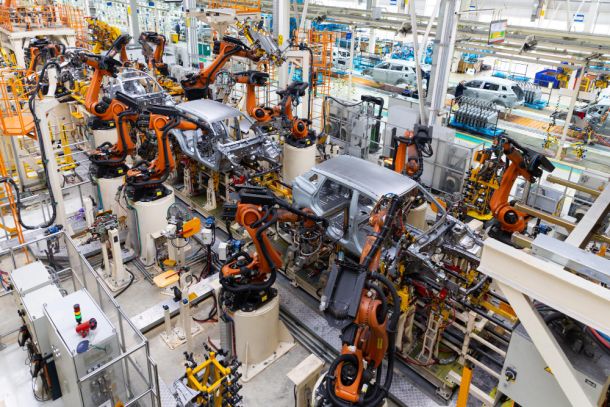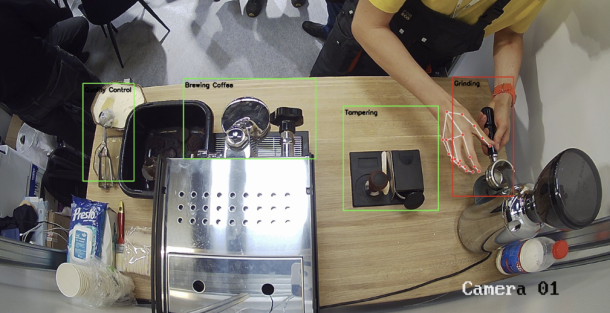Inventory replenishment methods
For sure each business leader wants to succeed and stand out from the competition. In this article we focus on some aspects of inventory replenishment and asset management and their impact on general performance of the organization. You will discover techniques on prioritizing production with ABC analysis, planning inventory replenishment with Q and P systems and 2 case studies when implementation of these methods delivered positive outcomes and allowed companies to reduce expenses. Besides, we highlight the advantages of the automatic inventory replenishment system.
Let’s explain case study first and then jump into inventory theory.
decision on cost minimization that succeed
Massachusetts Institute of Technology (MIT) investigated successful inventory replenishment strategies that resulted in optimizing inappropriate initial organization of business processes. The best example is described in detail in one of research studies available on their digital repository MIT Libraries.
According to the case study, inventory costs of 5 cotton yarn spinning mills in China were decreased by 23% after investigating factors influencing total stock cost and working out a solution to mitigate them in order to reduce expenses. Sounds great, yeah.
Excel chart
The reason why we chose this case study despite its publication date in 2018 (quite a long time ago) is that the inventory replenishment models used there to optimize stock levels and procurement costs are still up to date. There is nothing new under the sun. The thing is to pick up a time-proved inventory replenishment policy and make adjustments suitable for your case.
MORE DETAILS
The number of material ordered for yarn spinning grew from 7.9K tones in 2002/2003 to 31.6K tones in 2016/2017, consequently causing the increase of the level of annual expenses on procurement of cotton. At the end of the Season 2016/2017 the overage inventory level of cotton made up 20K tones and inventory level of yarn - approximately 1,5K. Maintaining stocks in the warehouse had a holding cost that amounted to RMB $16.9M. (the data provided by financial and supply chain departments stated in the research study).
The objective of the study was directed to find out the ways of optimizing inventory replenishment policy to minimize costs spent on warehouse yarn assets and cotton stocks. They decouple steps in Production - Distribution - Consumption process and revealed bottlenecks in their approach to transportation and warehouse logistics.
Cotton was purchased both from domestic and overseas suppliers and stored in 7 warehouses in different locations. The yarn products were either stored in a warehouse or delivered to customers. The company used trucks and trains for transportation raw material from suppliers to warehouse and finished products from warehouse to customers.
INVENTORY REPLENISHMENT SOLUTION
As different products require different amounts of material to produce and the profit of selling them is also different, the company split items into classes (we will describe ABC analysis in the next part of the article), measure consumption of cotton needed for yarn spinning by a certain class and prioritize them. It gave a notion of what goods are more profitable to produce and production of what items is not so effective and should be stopped.
What changes in replenishment inventory planning made the difference in the end? They are:
1) Changing logistical transportation paths,
2) Сlosing two warehouses and relocating raw materials and finished products in other warehouses,
3) Ordering materials in smaller chunks and more frequently (replenishment inventory strategies such as Q and P models also are described below, just follow the article).
The bar graph represents how the overall cost spent on inventory changed before and after optimization. Although the expenses on transportation increased, holding costs fell dramatically.
Excel chart
Proposed replenishment system in inventory control allowed to lower stocks levels alongside holding costs. The solution saved RMB $8.16M of the total replenishment costs, meaning expenses were reduced by 23%.
Now it is high time to investigate the theoretical aspects of this issue starting with inventory replenishment meaning.
INVENTORY REPLENISHMENT DEFINITION
Inventory replenishment is one of the activities that comprises inventory management. Its function implies placing orders for goods to suppliers intime to meet customer demand. It can be achieved by means of accurate demand forecasting and determining a correct reorder point.
We don’t focus a lot on that because the answers to the question “What is inventory replenishment?” you can easily find it on Wikipedia. We consider it more important to provide you with tools that can help the organization to leverage their resources.
INVENTORY REPLENISHMENT STARTS WITH PLANNING
The first step in inventory replenishment process is identifying the range of goods and its quantity with the aim to provide production with necessary assets. Well-established corporations prefer an automatic inventory replenishment system to manual one while small businesses often run accounting inventory and asset management manually.
To ensure continuous supply of goods, material managers refer to certain strategies to inventory replenishment: either based on a fixed order quantity model (Q system) or fixed order period model (P system).
According to the Q model, material managers replenish inventory as soon as the amount of certain items reaches reorder point. It requires continuous monitoring and human interaction. As for the P model, inventory replenishment happens in a specified period of time. To avoid shortage of material before the next supply, initially the multiple amount of goods is ordered. These methods apply for both a manual and inventory replenishment software.
OVERSTOCKING DERIVES FROM INCORRECT REPLENISHMENT INVENTORY METHODS
When we follow stories of success, we often neglect those who failed, however they are still a point of discussion. They are not “lucky”, but luck in this case implies not having enough knowledge in the domain industry that starts the process of making continuous mistakes. That’s why we are going to clear up ABC analysis as one of the inventory replenishment techniques. It has a crucial impact on keeping up the right stock balance as it arranges multiple products in order of their importance so that you can get to grips with the most important items first.
Let’s observe this one of the mentioned inventory planning and replenishment methods in practice. The example of having a big safety stock to fulfill the demand is described in the Case Study on Inventory management Improvement carried out by Riga technical University. They investigated performance indicators of an organization that specializes in assembling microchips.
At the end of the accounting period, the assembled quantity of microchips turned out to be higher than the sold one. Among multiple types of inventory replenishment systems, the chosen one led to the situation when the former were stored in a warehouse for the next year and caused overhead holding costs. What’s more, the company has a large amount of inventory already in stock before they assemble new batches of microchips. Unfortunately, it is not taken into account and material planning was inappropriate that results in an excess of products at the end of the accounting period.
Since inventory replenishment software hegde against such unpleasant occasions, we would discuss it soon (if you hurry, this link is for you: Automated inventory management system) . As for now, let’s turn to the bar graph that shows the relation between items assembled, sold and stocked.
Excel chart
The advantage of the automatic inventory replenishment system lies in its ability to forecast demands for the next year based on the analysis of data related to the previous accounting period. This forecasting can be used by supply chain managers to adjust inventory replenishment policy.
ABC analysis
Inventory replenishment best practices call attention to ABC analysis as an initial step in effective demand planning. There are several ways to interpret the ABC model for classifying inventory, nevertheless the core idea is to assign priority on products, because some of them generate more revenue.
It presumes that Class A items that make up 20% of the entire assets contribute to 80% of revenue, while the share of revenue gained through selling Class B items equals only 15%. Assets classified as Class C bring the last 5% of income. This correlation is shown on the graph below.
This technique interferes with Pareto principle according to which the 80% of results gained through 20% efforts. To make it more manufacturing-related, it implies that 80% of revenue comes as a result of selling small quantities of particular items that make up 20% of the stocks. The 80/20 productivity rule is also highlitended in Forbes 2023 guide on managing inventory effectively.
The thing is to indicate the importance of each category of items produced by the manufacturing company and classify what ensures top revenues, what less and the least. Bear in mind that demand planning and controlling assets of different classes requires different approaches. Mostly it concerns the frequency of inspections that is much easier to perform with the automatic inventory replenishment system.
Diversify your efforts regarding stocks and asset management practices wisely!
|
Inspection of stock levels |
Reviewing demand forecasts |
Calculating Usage rate |
Cycle counting |
|
|
Class A |
often |
often |
often |
often |
|
Class B |
regularly |
regularly |
regularly |
regularly |
|
Class C |
infrequently |
infrequently |
infrequently |
infrequently |
DATA INSTEAD OF INTUITION
The company set up a time period for replenishment of 5 months that would hedge against unplanned inventory falling under re-ordered points. It ensured enough time to replenish cotton assets before they are needed for yard spinning, but it didn’t hedge against the unexpected shortage of material.
You can read more about the automatic inventory replenishment system that tracks assets in stock in real time here. Many manufacturers admit that automatic asset and inventory management systems have an advantage over manual ones. And further we provide the rationale for digitization of manufacturing.
The automatic inventory replenishment system facilitates the whole process of inventory and asset management. It comprises ABC analysis, inventory forecasting, resupplies guidelines and tracking assembling order status. Besides, these technological solutions fulfill the function of generating reports automatically and warning about the amount of materials in stock. It works as a tool for decision-making based on analytics hedging against risks of human errors that often come as a result of maintaining and interpreting stock records manually.
Although automatic stocks tracking and demand forecasting are admittedly useful practices to run business successfully, there are still companies that step aside data-driven inventory replenishment planning and do it on a hunch. Hope, this article provides a profound explanation of the necessity to carefully execute the inventory replenishment techniques to minimize expenses and increase revenues. Follow these recommendations or ignore them, it’s up to business executives and material managers.
Min-Max is one of the Official 5controlS algorithms. Plug it in our video monitoring system with AI analysis and ERP Integration (Open Source) to facilitate supply chain management and keep up the optimal stock levels.
With the integration of the Min-Max Inventory Control System, you can now effortlessly manage your manufacturing reserves and ensure smooth and uninterrupted production processes. This system is designed to help you maintain the optimal stock levels by providing real-time inventory tracking and analysis. It allows you to make informed decisions and avoid costly production line stoppages.
Moreover, our software products are FREE. You can access our code and contribute to our projects on our GitHub page. We believe in open-source and want to build a community that contributes to and benefits from our software.












